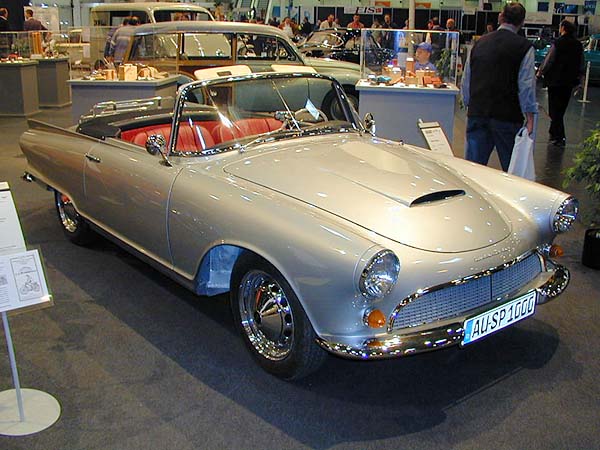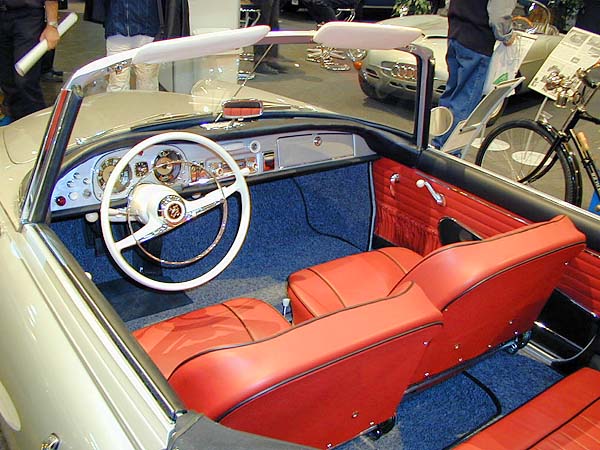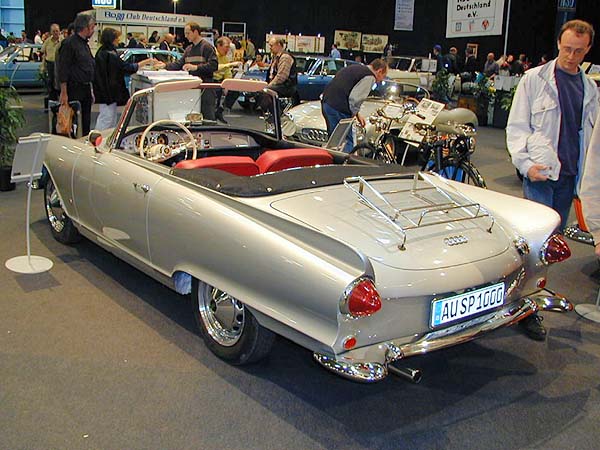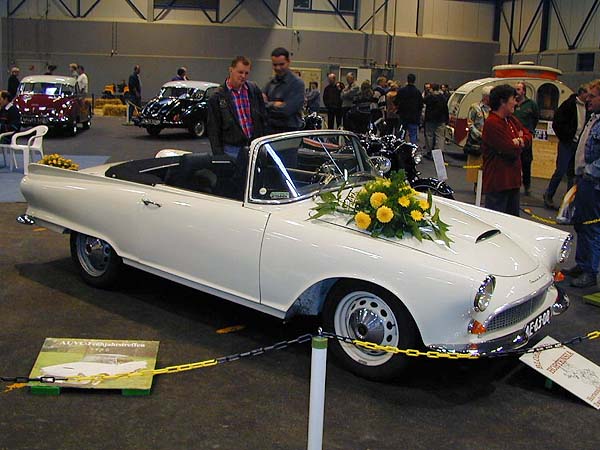|
 The Auto Union (DKW) 1000Sp coupe was joined by a roadster version in 1961. It looked even more glamorous than the coupe, an aspect stressed by the factory by advertising it with the help of beauty queens and movie stars. The Auto Union (DKW) 1000Sp coupe was joined by a roadster version in 1961. It looked even more glamorous than the coupe, an aspect stressed by the factory by advertising it with the help of beauty queens and movie stars.
 The 1000Sp wasn't only pretty on the exterior, it had an interior to match. The interior was well finished with a variety of chrome accents, an almost monumental steering wheel in ivory or black colored plastic, elaborate dials and switches, full carpetting and adjustable front seats. A small rear bench was included as well, but could only be occupied by very small children. The 1000Sp wasn't only pretty on the exterior, it had an interior to match. The interior was well finished with a variety of chrome accents, an almost monumental steering wheel in ivory or black colored plastic, elaborate dials and switches, full carpetting and adjustable front seats. A small rear bench was included as well, but could only be occupied by very small children.
 The 1000Sp roadster was equally as expensive as the coupe. It may have been an extravagant price for a small car with such humble origins, but if you look at the detailing and finishing of this car its quite clear that it couldn't have been a cheap car to produce. The 1000Sp roadster was equally as expensive as the coupe. It may have been an extravagant price for a small car with such humble origins, but if you look at the detailing and finishing of this car its quite clear that it couldn't have been a cheap car to produce.
To invoke a more upper class association the DKW name was temporarily substituted by Auto Union in 1958. This only applied to the 1000 cc models and with the end of this range of models in 1965 also the Auto Union name disappeared for good.
 A nice aesthetic touch of the 1000Sp roadster was that its hood completely folded away into the bodywork. This way the crisp-cut lines of the model weren't spoiled by a lump of fabric sitting on top of the rear deck. A nice aesthetic touch of the 1000Sp roadster was that its hood completely folded away into the bodywork. This way the crisp-cut lines of the model weren't spoiled by a lump of fabric sitting on top of the rear deck.
Not only the price of the roadster was similar to that of the coupe, also the technology underneath was identical. It had the same measurements and only weighed 30 kg less. Top speed was also 140 kph.
During the lifespan of the 1000Sp only small changes and improvements were made. Most noticeable were the introduction of an automatic oil pump for mixing the fuel for the 2-stroke engine in 1961 and front disc brakes in 1963.
The end for both the 1000Sp coupe and roadster came in April 1965. Only 1640 roadsters were sold, which now makes it the most valuable classic of them both. The 1000 cc models were replaced by the DKW F102 in 1964, which was to be the last DKW model. DKW had been bought by Volkswagen from Daimler-Benz in 1965. Volkswagen immediately fitted the F102 with a Daimler-Benz designed 4-cylinder 4-stroke engine and named it the Audi, another brand from the rich Auto Union history. The 2-stroke DKW F102 was taken out of production in spring 1966 and Audi went on to become Volkswagens premium brand it is today, built on the foundation laid by DKW.
In a way you can consider the 1000Sp as the swan song of DKW, the epitome of a long history of making 2-stroke front wheel drive cars. Not only does it look good, it's also a special part of automotive history, a worthy conclusion to the 2-stroke era (though 2-stroke engines kept rattling away in Eastern Germany for decades thereafter). The 1000Sp is a gem of typical European engineering in a disguise of American forward thinking and special to anyone interested in automotive history.
|
